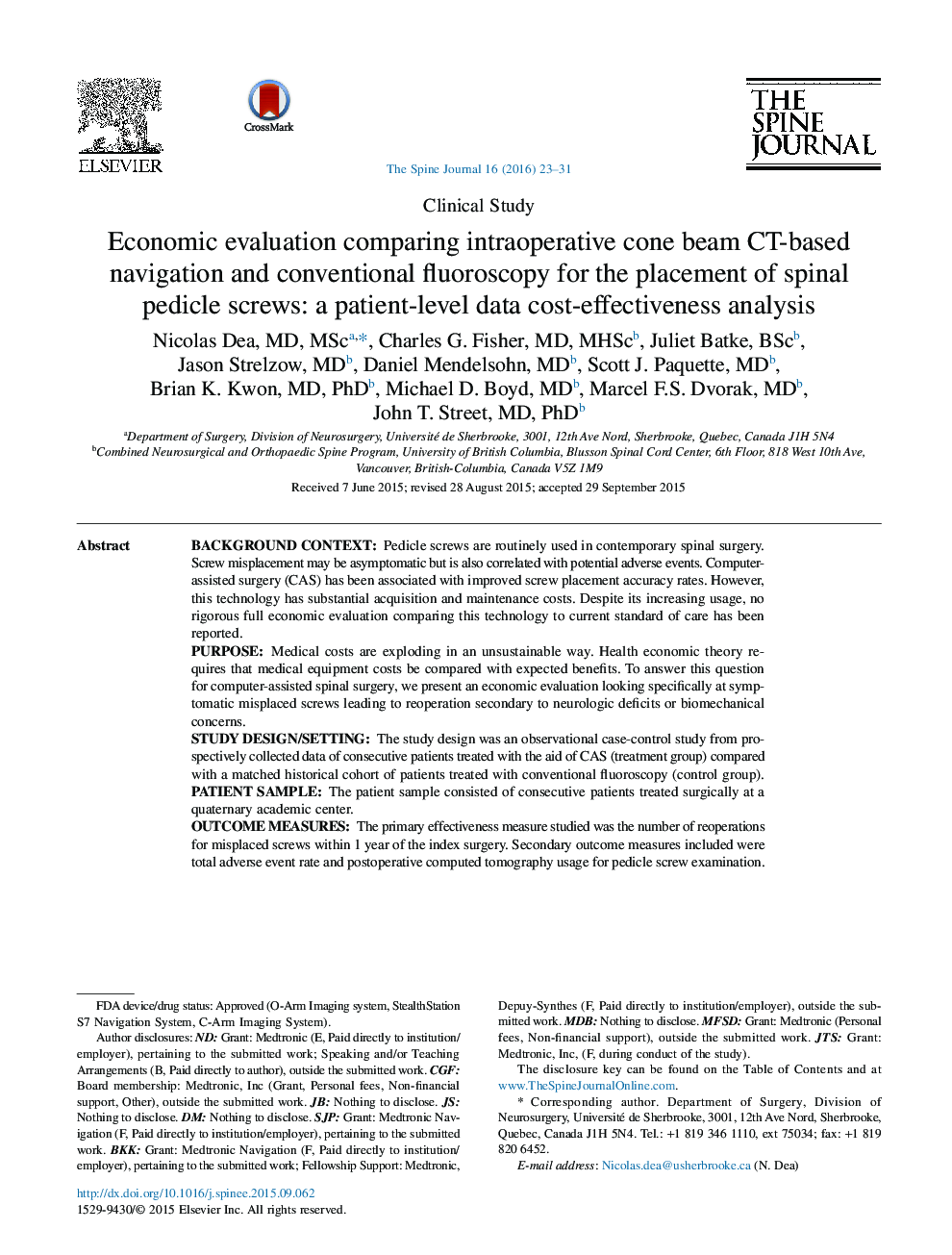| کد مقاله | کد نشریه | سال انتشار | مقاله انگلیسی | نسخه تمام متن |
|---|---|---|---|---|
| 4096448 | 1268562 | 2016 | 9 صفحه PDF | دانلود رایگان |

Background ContextPedicle screws are routinely used in contemporary spinal surgery. Screw misplacement may be asymptomatic but is also correlated with potential adverse events. Computer-assisted surgery (CAS) has been associated with improved screw placement accuracy rates. However, this technology has substantial acquisition and maintenance costs. Despite its increasing usage, no rigorous full economic evaluation comparing this technology to current standard of care has been reported.PurposeMedical costs are exploding in an unsustainable way. Health economic theory requires that medical equipment costs be compared with expected benefits. To answer this question for computer-assisted spinal surgery, we present an economic evaluation looking specifically at symptomatic misplaced screws leading to reoperation secondary to neurologic deficits or biomechanical concerns.Study Design/SettingThe study design was an observational case-control study from prospectively collected data of consecutive patients treated with the aid of CAS (treatment group) compared with a matched historical cohort of patients treated with conventional fluoroscopy (control group).Patient SampleThe patient sample consisted of consecutive patients treated surgically at a quaternary academic center.Outcome MeasuresThe primary effectiveness measure studied was the number of reoperations for misplaced screws within 1 year of the index surgery. Secondary outcome measures included were total adverse event rate and postoperative computed tomography usage for pedicle screw examination.MethodsA patient-level data cost-effectiveness analysis from the hospital perspective was conducted to determine the value of a navigation system coupled with intraoperative 3-D imaging (O-arm Imaging and the StealthStation S7 Navigation Systems, Medtronic, Louisville, CO, USA) in adult spinal surgery. The capital costs for both alternatives were reported as equivalent annual costs based on the annuitization of capital expenditures method using a 3% discount rate and a 7-year amortization period. Annual maintenance costs were also added. Finally, reoperation costs using a micro-costing approach were calculated for both groups. An incremental cost-effectiveness ratio was calculated and reported as cost per reoperation avoided. Based on reoperation costs in Canada and in the United States, a minimal caseload was calculated for the more expensive alternative to be cost saving. Sensitivity analyses were also conducted.ResultsA total of 5,132 pedicle screws were inserted in 502 patients during the study period: 2,682 screws in 253 patients in the treatment group and 2,450 screws in 249 patients in the control group. Overall accuracy rates were 95.2% for the treatment group and 86.9% for the control group. Within 1 year post treatment, two patients (0.8%) required a revision surgery in the treatment group compared with 15 patients (6%) in the control group. An incremental cost-effectiveness ratio of $15,961 per reoperation avoided was calculated for the CAS group. Based on a reoperation cost of $12,618, this new technology becomes cost saving for centers performing more than 254 instrumented spinal procedures per year.ConclusionsComputer-assisted spinal surgery has the potential to reduce reoperation rates and thus to have serious cost-effectiveness and policy implications. High acquisition and maintenance costs of this technology can be offset by equally high reoperation costs. Our cost-effectiveness analysis showed that for high-volume centers with a similar case complexity to the studied population, this technology is economically justified.
Journal: The Spine Journal - Volume 16, Issue 1, 1 January 2016, Pages 23–31